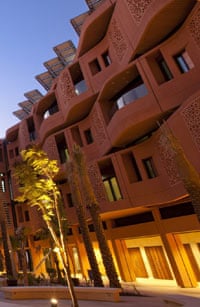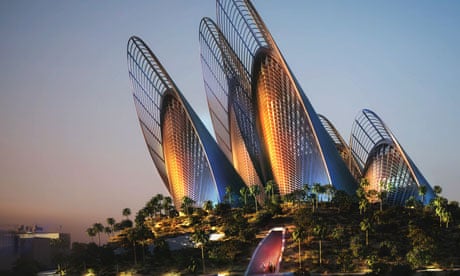An echelon of white cars stands in a grey concrete undercroft. They are electric and, more remarkably, driverless. I press a button, enter one and am swished to my destination, at speeds of up to 50kmh, guided by magnetic sensors embedded in the road. An omniscient computer makes sure that I go where I want and that I don't collide with other cars. A honeyed voice tells me, in American and Arabic, where I'm going. "Salaam alaikum," she adds.
It is like a hyper-disciplined dodgem or a cab in which the cabbie has been replaced by a chip. So far, it only runs between two stops, but it could become the main transport system for Masdar City in Abu Dhabi, whose population will eventually be 50,000, with thousands more working there every day. Masdar's carbon emissions will, it is promised, be zero. Along with Dongtan, China, it is one of the most celebrated eco-town projects in the world.
Abu Dhabi is more responsible than Dubai. It has more oil, more money and less need to gamble. It is investing a sliver of its wealth in Masdar, doubtless to look good, but also to insure against the still-distant day when the oil runs out by making itself a centre of sustainable energy. The first part of the city, the Institute for Science and Technology, is now complete.
The architects for Masdar are Norman Foster and his practice, Foster and Partners. Foster, now aged 75, has many millions in the bank, many hundreds on his staff, piles of honours and seems to want to do good in the world. "Slum housing," he says, when I ask him what he most wants to address next, and the Norman Foster Foundation is funding low-cost schools in Sierra Leone. Masdar, as a conspicuous contribution to rescuing the planet, is near to his heart. He is also excited by Abu Dhabi's planned museum in honour of the late Sheikh Zayed, the founder of the United Arab Emirates. Masdar is a work of serious intent, thoroughly applied. The museum looks a bit daft. How can this be?
Masdar does not just pursue its ends with fancy equipment. It starts, says Foster, with "the principle of learning from past traditions, the accumulated wisdom of centuries", which grand statement means applying the techniques of traditional Arab cities in hot places such as Yemen. So the city is being built with steep streets creating deep shadow and oriented to catch the prevailing wind. The roofscape is made irregular, to create turbulence and direct breezes down into the streets.
The planning is compact, so places are closer to each other, to encourage walking. Buildings are given a heavy mass, so they cool and warm more slowly, evening out the temperature changes from day to night. Patterned screens, based on the traditional Islamic mashrabiya, filter light and breeze. Everything, from the sourcing of timber to the water consumption of the plants, is scrupulously considered.

By saving energy and using natural cooling techniques, Masdar reduces the energy that has to be produced by the solar panels on the roofs and in the surrounding landscape. It also genuinely succeeds in creating some of the virtues of old cities: it is a positive delight to walk its shaded streets, which cannot be said of many public places in Abu Dhabi. Sustainability, in other words, shapes architecture and town planning for the better and is not just a series of technical fixes.
The Masdar plan has been accused of being gated and exclusive. It is not, although there is something spooky in the controls it employs in the name of the environment – a touch of eco-Orwell or at least eco-Huxley. A hidden brain, for example, knows when you enter your building, so that your flat can be cooled before you arrive, while in public places flat screens broadcast uplifting news on the environmental performance of the complex.
Another question is whether it is only a gesture, a green bauble like the wind turbine David Cameron put on his house, only on a larger scale. Here, only time will tell, but the purpose of the institute is to study the effectiveness of Masdar's techniques, so that they can be applied elsewhere.
The Zayed National Museum also takes sustainability as its theme. The sheikh liked falconry, apparently, which Foster says inspired the design. "If you take the reality of soaring birds – raptors, hunting birds – they spend most of their time soaring, not flapping. They capture a thermal." He tells me that gliders do this too and here autobiography enters the picture, as Foster has flown them for decades. From this, it follows that the museum will be surmounted by five giant steel feathers, which use the aerodynamic principles of birds and planes to draw cooling air through the building.
The museum's exhibits are buried under a palm-covered mound, contained in five galleries, in five flask-shaped containers, each cooled by air from one of the feathers above. Exactly what the exhibits will be is secret: we know only that the director of the British Museum, Neil MacGregor, is advising on them and they will follow themes dear to Sheikh Zayed, such as learning and nature.
However, the feathers and flasks look like an extraordinarily elaborate way to cool five exhibition galleries and associated facilities. The museum suffers from a touch of the Millennium Domes, with extravagant architecture running ahead of uncertain content. It also looks, well, kitsch, not fundamentally different from projects shaped like horses' heads and pearls, which you can find in Dubai, even if we can expect the Foster office to bring a degree of quality to its execution.
It is best appreciated, perhaps, as a work of outrageous petrodollar baroque, in a tradition that goes back to the 1970s, and which will be rediscovered with affectionate irony by some Wallpaper* magazine of the future.
For Foster, the aim was "to enhance the memory of this individual and to make this nation aware of its history. If you're looking forward to the future, it's important to remember your roots and history". He is responding to his clients' desire for something "more symbolic, more expressive, more powerful". "It is not an empty gesture, but a powerful pointer," he says and it is given validity by its greenness: it represents the "agenda of a country that, whatever criticisms there might be, is none the less achieving zero energy through inspired examples or, if not, going a long way in that direction". Asked if it might look like propaganda, he says: "Then so does Nelson's column."
Foster's approach is to treat everything as a problem in search of a solution, whether that problem is technical, environmental, cultural or symbolic. It works well with Masdar, which matches some of his best work over the decades, even though it sometimes feels like a composite of solutions rather than an integrated whole. The approach works less well with the museum, which veers between the fantastical and the technical, without bringing them together.
When he speaks, Foster likes to cite disparate things – birds, machines, people – but he doesn't get them to cohere or engage. Rather, his buildings create a kind of gap, a neutral space, in which differences are smoothed over. That is how he is and I don't think he will change now.
